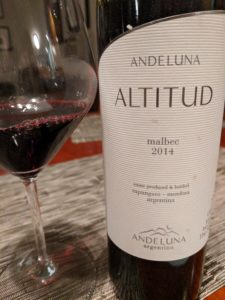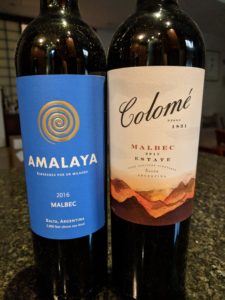 It’s time to break out the barbecue as we anticipate the arrival of fairer weather and grilling season this weekend. Plus, it’s time to celebrate Argentina’s signature grape variety on World Malbec Day, which takes place on April 17, 2018.
It’s time to break out the barbecue as we anticipate the arrival of fairer weather and grilling season this weekend. Plus, it’s time to celebrate Argentina’s signature grape variety on World Malbec Day, which takes place on April 17, 2018.
Admittedly, Malbec got its start in southwest France (think Cahors and – to a lesser extent – Bordeaux), having been cultivated in the area since Roman times. But the grape has been quite successful in making a home for itself in the Mendoza region of Argentina.
In fact, Argentina’s long relationship with Malbec dates to 1853 when agronomist Michel Aimé Pouget brought the grape to the New World country, having been hired to run an agricultural school there. On April 17th of that year, a bill was submitted to the legislature to establish the new school and was passed into law by early September. In addition to the school’s influence, Argentina’s early viticulture was also shaped by Italian and French immigrants, who brought their grape growing experience and expertise with them. Moreover, Malbec quickly adapted to its new home, rising in popularity and prominence. However, it wasn’t until 2011 that World Malbec Day took place for the first time.
On its own, this variety offers up fresh fruit aromas of black and bramble fruit and violet, usually joined by oak, vanilla due to barrel aging regimens. It generally produces wines with medium-to-full body, moderate-to-firm tannins and medium-to-high alcohol levels. Malbec grapes grown at the higher elevations found in the Andes Mountains benefit from the good diurnal variation and long hang time, developing thick skins and concentrated flavors.
But, while World Malbec Day is a great excuse to open up a Malbec wine, it is also a wonderful opportunity to celebrate Argentina’s wines in all their splendor and diversity. At the 11th edition of the Argentina Wine Awards, well titled as “Breaking New Ground,” 47 wines earned a score of 95 points and 17 wines received trophies: 6 red blends, 5 Malbecs, 1 Cabernet Sauvignon, 1 Cabernet Franc, 1 Chardonnay, 1 sparkling wine, 1 white blend and 1 sweet wine, proving that Argentina can produce more than just Malbec.
Of course, like wines from elsewhere, Argentine wines can be enjoyed with nearly any cuisine. However, with its adopted home being among the steak capitals of the world, it can be the perfect pairing partner for these wines.
 In gearing up for the “holiday,” Hess Family Wine Estates sent out recipes for meals featuring Grilled Tomahawk Steak with Squash And Zesty Watercress Salad (Amalaya recipe) and another for Seared Lamb with Fresh Corn & Quinoa Soup (Colomé recipe), to be enjoyed with its Colomé Malbec 2015, Salta, Argentina, $25.00 (100% Malbec)* and Amalaya Malbec 2016, Salta, Argentina, $16.00 (85% Malbec, 10% Tannat, 5% Petit Verdot) wines. I happily indulged in the recipes, tweaking them a bit to fit our tastes and our pantry.
In gearing up for the “holiday,” Hess Family Wine Estates sent out recipes for meals featuring Grilled Tomahawk Steak with Squash And Zesty Watercress Salad (Amalaya recipe) and another for Seared Lamb with Fresh Corn & Quinoa Soup (Colomé recipe), to be enjoyed with its Colomé Malbec 2015, Salta, Argentina, $25.00 (100% Malbec)* and Amalaya Malbec 2016, Salta, Argentina, $16.00 (85% Malbec, 10% Tannat, 5% Petit Verdot) wines. I happily indulged in the recipes, tweaking them a bit to fit our tastes and our pantry.
Specifically, we decided to cook our steaks in our cast iron skillet using a spice rub (we live in a NYC apartment and don’t have access to a grill), substituted a very large sweet potato in place of butternut squash and chose to forgo the other vegetables in the “squash with vegetable chips.” For the watercress salad, we skipped the habanero peppers and used lemon juice instead of lemon zest, with salt, pepper and good quality EVOO.
We also added the corn and quinoa soup to our meal from the Colome menu since it sounded so good. If you can grill your corn, it will definitely add a layer of depth and complexity, but you can just as easily “cheat” like I did and use a bag of frozen corn (much easier than wrestling the kernels off an ear of corn). The recipe calls for white quinoa, but we only had red quinoa and you can use the general quinoa ratio (1 cup quinoa to 2 cups water) rather than try to figure out 5.3 oz of quinoa. If you are dairy-free, substitute ghee or olive oil. I also added in some Cayenne pepper to give the soup a bit of a welcome (to us) kick.
All in all, it was a delicious dinner and went quite well with the two Cabernet Sauvignon wines.
TASTING NOTES
Viña Cobos Bramare Marchiori Vineyard Chardonnay 2016, Perdriel/Lujan de Cuyo, Argentina, $42.00
This wine was barrel fermented with native yeasts and underwent malolactic fermentation while in barrel. It then spent 12 months in French oak barrels, 50% of which were new. Despite the oak treatment, the oak character was relatively integrated and balanced, along with rich apple and tropical fruit flavors.
Amalaya Malbec 2016, Salta, Argentina, $16.00
This wine brings together 85% Malbec with 10% Tannat and 5% Petit Verdot. On the nose, the wine shows an intensity of berries, bramble fruit and a hint of smoke, which persist on the dry, full-bodied palate, balanced out with medium+ acidity and medium+ ripe tannins.
Andeluna Altitud Malbec 2014, Tupungato, Mendoza, Argentina, $20.00
Deep inky purple in color, this wine displays berries, oak, vanilla and a hint of earth on the nose. On the palate, it is dry with ripe black cherry and blackberry fruit, joined by some oak and herbal notes, with medium+ acidity, firm tannins, full body and medium+ length.
 Colomé Malbec 2015, Salta, Argentina, $25.00
Colomé Malbec 2015, Salta, Argentina, $25.00
This wine spent 15 months aging in French oak barrels, which comes across as smoke and oak on both the nose and palate, joined by a slight floral note. It offers up good acidity with lots of blackberry and plum flavors, along with an herbal undercurrent and a long finish.
Vincentin Colosso 2014, Luyan de Cuyo and Valle de Uco, Mendoza, Argentina, $45.00
A blend of 94% Malbec, with 3% each of Petit Verdot and Cabernet Franc, this wine was aged for 24 months in new French oak barrels. It has an intense woody, red fruit, berries, spice and vanilla nose, which all persist on the dry, medium+-bodied palate, culminating in long length.
Bodega Sottano Reserva de Familia Malbec 2015, Luyan de Coyo, Mendoza, Argentina, $30.00
This wine spent 15 months in new oak (70% French and 30% American) barrels. The wine’s intense nose provides notes of plum, bramble fruit, oak and a hint of perfume, all of which persist on the luscious palate. An intensity of fruit character dominates, but the wine is also very fresh, with balance and long length.
Bodegas Norton Gernot Langes 2012, Luyan de Cuyo, Mendoza, Argentina, $100.00
This 80% Malbec, 10% Cabernet Sauvignon, 10% Cabernet Franc blend has an intense nose of violets, oak, cedar, berries and vanilla. Its palate is dry with a sweet attack of ripe fruit of blackberries, black cherry, firm tannins, full body and long length. It is a powerful and concentrated wine that will improve with bottle age.
Viña Cobos Cocodrilo Corte 2015, Luyan de Cuyo and Valley de Uco, Mendoza, Argentina, $28.00*
Bringing together 77% Cabernet Sauvignon with 15% Malbec and 8% Cabernet Franc, this Bordeaux-style blend is lush with ripe fruit on the nose and palate, redolent of blackberry, black cherry and a woody undercurrent. It shows good acidity, with firm tannins and medium+ body on the powerful and rich palate.
Bodega Luigi Bosca Finca Los Nobles Field Blend Cabernet Bouchet, 2012, Mendoza, Argentina, $70.00*
Produced from a blend of Cabernet Sauvignon and Alicante Bouchet grapes that have been grown together for more than 90 years, at an altitude of 1,050 meters above sea level, this wine is then aged for 24 months in new French oak barrels. This is an elegant, yet powerful wine, with classic Cabernet Sauvignon characteristics. It displays aromas and flavors of blackberry, oak, smoke, herbs and dried flowers with bright acidity, firm tannins, and full body.
Proemio Reserve Syrah Garnacha 2015, Mendoza, Argentina, $20.00
The 50-50 blend was co-fermented before being aged for 12 months in French oak. With aromas of cloves, leather and black cherry, the dry wine then offers up bright acidity, black cherry, oak, spice, firm tannins and long length on its palate. A really lovely wine, especially for the price.
*Argentina Wine Awards Trophy Winner
